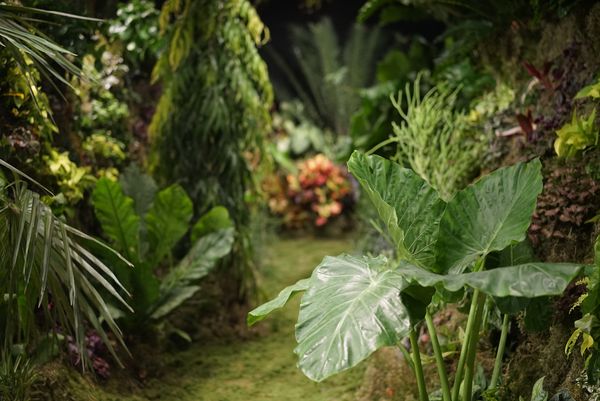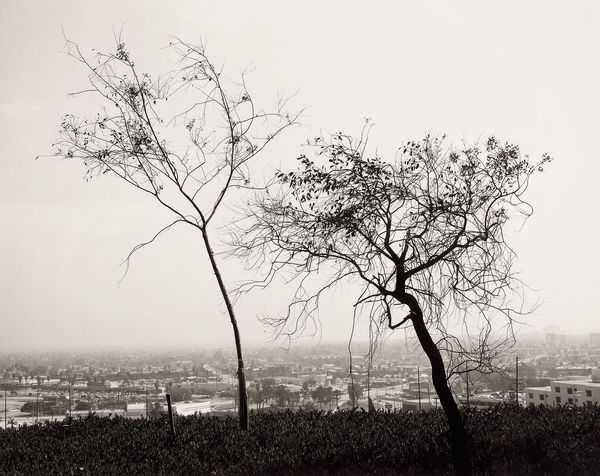Lily Kwong photographed by Gesi Schilling.
Project: "Moongates" at Bal Harbour Shops, Miami. Art Basel Miami Beach 2019.
This season, Phillips Photographs is proud to present a selection of landscape photography curated for our pre-sale exhibition in partnership with artist Lily Kwong. The San Francisco-Bay Area native has extensive experience as a landscape artist, work that has taken her across the country and indeed around the world. We had the chance to speak with Lily and find out more about her work, process and passion for photography.
PHILLIPS: Tell us about your background as a creator. What was your journey to becoming a landscape artist?
LILY KWONG: My journey began in the Redwood trees of Northern California. I grew up in the green cathedral of Muir Woods in Marin County, and spent most of my time running around the Headlands & Mount Tamalpais State Park. My mother is a true genius with her hands - weekends were spent with her leading some ambitious craft project that often involved painting, sewing or collaging - and one of my favorite pastimes was building these elaborate forts in the woods. My entry point into a formal arts practice was through photography, and I spent my high school years taking SFAI’s pre-college courses. By the time I landed at Columbia University after a couple of years traveling and working in the fashion industry, I had locked into urban studies research and my first job out of school put me at a landscape design studio in Miami. It was in South Florida that I fell into a deep love with tropical plants, and spent several years as a project director traveling the world facilitating large-scale landscape master-planning projects from Central West Africa to the LVMH Design District. Once I got a handle on the operational and logistical demands of my industry, I began to revisit my more experimental early days of art-marking. I founded Studio Lily Kwong in 2016, and since then we have created large-scale botanical art pieces on the High Line, Grand Central Station, the Whitney Museum shops and more. Our mission is to reconnect people to nature, and our team works tirelessly to make cities greener and more soulful places to live in.
"Highland Park Orkadia" at Grand Central Station, New York. Photography by Kevin Fabrizi.
P: When creating a new biophilic installation, where do you begin? How would you describe the process of working with a living medium?
LK: I live between New York and Los Angeles, but try to deeply immerse myself in nature as much as possible. I’ve done ecological research around the American West, New Zealand, Singapore and beyond, and at this point, I have a pretty strong library of natural forms in my archive. I’m a big believer in ‘first idea, best idea’ and have grown to trust my intuitive relationship to the natural world the further I’ve delved into my practice. I’m usually playing with a couple big themes or forms - for example, mountain ranges or a concept I’m calling ‘landscape biographies’ - and the vision will hit me pretty immediately when I walk into a new project space. The 15’ mountains we built in Grand Central Station in 2018 were from the first sketch I drew in my notebook at our initial site visit, and our “Moongates” piece for this Art Basel Miami came a from renewed examination of my personal ethnic identity and Chinese landscape architectural forms. I read a lot of philosophy and books on ecology, and along with my travels, it all weaves into the installation work we are exploring as a studio.

"Moongates" at Bal Harbour Shops, Miami. Photography by Gesi Schilling.
P: Who are some artists, of any discipline, that inspire you?
LK: There are so many land artists who paved the way for what I do, and I have a lot of respect and gratitude for figures like Agnes Denes, Maya Lin and Andy Goldsworthy. I have always felt very moved by great painters like Cézanne, Hilma af Klint and O’Keefe. Contemporary landscape designers like Luciano Giubbilei, Raymond Jungles, Topiairis Landscape and Walter Hood give me something to aspire to. David Byrne is one of my original heroes for his fearlessness to explore all forms of creativity, and I feel very inspired by my art-making friends and contemporaries like Curtis Talwst Santiago, collaborators Aya Rodriguez-Izumi & Gary Gunn, and my photographer pals like Shaniqwa Jarvis, John Chiara and Erica Deeman. I rely heavily on books and literature for my creative spark - some books that have impacted me recently: Braiding Sweetgrass by Robin Wall Kimmerer, Lo-TEK. Design by Radical Indigenism by Julia Watson, Stand Still Like the Hummingbird by Henry Miller and The Life and Death of American Cities by Jane Jacobs. A journalist just pointed out that my work is very cinematic, and I grew up watching the greats with my filmmaker dad - so as you can see, the inspiration pool is pretty wide.
Lot 36: Robert Adams On Signal Hill Overlooking Long Beach, 1983.
Estimate: $15,000-25,000.
Photographs, New York.
P: You’ve had an interest in photography from an early age. How did this come about?
LK: My passion for photography traces back to curator Chris McCall. He is my first true art teacher, and a dear friend and collaborator to this day. Chris was my photography teacher starting at 14-years-old at the Urban School of San Francisco and went on to become the curator of the celebrated Pier 24 Photography. In many ways, I feel like Chris gave me my way of seeing - he inspired a whole generation of young photography students & creators. He had a non-traditional way of teaching photography (and eventually, a non-traditional way of curating it) - he demanded we understand photography through the lens of visual literacy, and contextualize images in a greater ecology of sociological and cultural forces. We were expected to not only make work in high school, but curate full art shows that often involved mixed-media and language. I remember creating a Jim Goldberg-inspired oral history and portrait project for my senior thesis that involved capturing images of my teenage friends and our middle-aged parents & teachers, and then inviting them to write directly about age & the passing of time on the photographs. Chris took a personal interest in my work and became a close family friend - he urged me to study photography at SF Art Institute, and helped me secure my first internship at the renowned Fraenkel Gallery, where partner Frish Brandt became an early mentor of mine. I remember handwriting & mailing a fan letter to Todd Hido at 18-years-old, and Todd eventually took photographs of me on a moody Bay Area day - I still cherish those images. I was truly obsessed with photography, and meticulously collected the books of Richard Misrach, Paul Graham, Katy Grannan, Robert Adams and more. Some of these photographers you even see in the auction today - my love for this medium remains strong in my heart. It was a real return to my roots to curate this show, and having Chris’ guidance and support felt like a full circle.

"Summer in Winter" at Cadillac House, New York. Photography by Plamen Petkov.
P: What draws you to photography today? In what way does the medium continue to influence your work?
LK: Photography is fundamentally about light, and so is landscape design. A photographic image directly captures reflected light, and how the light moves across a garden giving the space its beauty and power. Quite literally, plants are constantly turning light into energy and then giving it away - in that sense, they can be our greatest teachers for reciprocity and generosity. My artistic impulse was shaped by photography, where I was trained to consider light, color, proportion and texture. These are still my primary concerns as a landscape artist, but I have this wonderful and challenging additional dimension of designing with a living medium. With landscape, you are also designing in a fourth dimension: time. You have to think about what a garden will look like Day 1, and also in 10 or 20 years. Similarly, I see photography as being in direct conversation with time and human perception - you are capturing a moment, and re-calibrating your relationship with time and your environment, just as a garden does.
Lot 217: Ryan McGinley Kudzu, 2014. Estimate: $15,000-25,000.
Photographs, New York.
P: Without giving too much away, what can you tell us about the selection of works you’ve curated in our Photographs auction? What are some of the common threads?
LK: All the photographs for this auction capture different dimensions of the natural world, with a special attention on trees. All of the images suggest a human touch, as if man is just out of the frame. Legible images of human beings are nowhere, and yet they’re felt everywhere in the photographs. Even the images of ‘unadulterated’ nature feel impacted somehow by mass development and human progress. Ultimately this show is about the Anthropocene epoch, or the dawn of the human-influenced age on nature. For the first time, human beings have had a significant impact on the Earth's geology and ecosystems -- the acceleration since the mid-20th century of carbon dioxide emissions and sea-level rise, the global mass extinction of species, and the transformation of land by deforestation marks the end of the previous era. We exist in a new landscape where the earth is now completely responsive to our actions, sadly mostly for the worse. There are many landscapes that feel abandoned, and ultimately I hope this show will inspire people to reconnect with nature and become stewards of the land again before it is too late.

"Shou Sugi Ban House" at Water Mill, New York. Photography by Fredrika Stjarne.
P: What’s next for you--are there any big projects we can look forward to seeing in 2020?
LK: Sadly many of our big projects were postponed due to the pandemic - we had been slotted to open a major public art piece for the 5th Ave BID this summer & had exciting development projects coming down the pike. So much of our work was around public art & community gathering, so we had to adapt and re-strategize. In April, we launched the “Freedom Gardens” initiative as our studio’s direct response to the most harrowing public health crisis of our lifetime. Drawing from the WW2-era ‘Victory Gardens’ movement, our initiative aims to help our community grow thriving edible gardens to support physical and mental health, and safeguard people from a volatile centralized food system. To learn more visit freedom-gardens.com or @freedom_gardens on Instagram.



